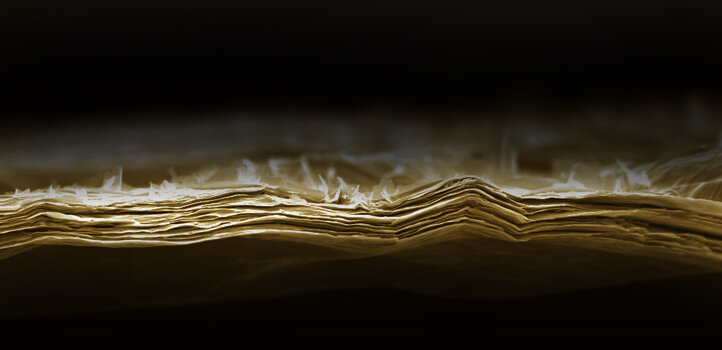Oct 13 2020
Researchers at KAUST have developed a layered material that can serve as an accurate temperature sensor by exploiting the same principle used in biological ion channels.
 This SEM image shows an as-prepared lamellar membrane out of MXene before exposure to water/light/heat. Image Credit: © KAUST 2020.
This SEM image shows an as-prepared lamellar membrane out of MXene before exposure to water/light/heat. Image Credit: © KAUST 2020.
Several proteins are present in human cells and act as channels for charged ions. A few ion channels present in the skin depend on heat to push a flow of ions that produces electrical signals, which can be utilized to sense the temperature of the environment.
KAUST researchers were motivated by such biological sensors and hence made a titanium carbide compound (Ti3C2Tx) called an MXene, which includes several layers with a thickness of just a few atoms. Negatively charged atoms, like fluorine or oxygen, cover each layer.
These groups act as spacers to keep neighboring nanosheets apart, allowing water molecules to enter the interplanar channels.
Seunghyun Hong, Postdoc, KAUST
Hong is also one of the members of the group that developed the new temperature sensor.
The thickness of the channels between the MXene layers is less than 1 nm. The team employed methods like scanning electron microscopy and X-ray diffraction to analyze their MXene. It was identified that the addition of water to the material somewhat increased the width of the channels between the layers.
When the material came into contact with potassium chloride solution, the channels turned sufficiently large to enable the movement of positive potassium ions through the MXene but blocked the path of negative chloride ions.
The researchers made a tiny device using the MXene and exposed one end of it to sunlight. Specifically, MXenes are efficient at absorbing sunlight and transforming that energy into heat.
The ensuing increase in temperature triggered potassium ions and water molecules to flow via the nanochannels to the warmer part from the cooler end—an effect called thermo-osmotic flow.
This led to a change in voltage similar to what is observed in biological temperature-sensing ion channels. Consequently, the device was able to sense the temperature changes reliably even below 1 °C.
When the saltiness of the potassium chloride solution was reduced, there was an improvement in the performance of the device, partially by further improvement in the selectivity of the channel for potassium ions.
When the intensity of light shining on the material was increased, its temperature and the ion-transporting response also increased at the same rate. This shows that apart from serving as a temperature sensor, the material could even help quantify light intensity.
The study was a result of the collaboration between the teams of KAUST professors Husam Alshareef and Peng Wang.
We envision that the MXene cation channels have promise for many potential applications, including temperature sensing, photodetection or photothermoelectric energy harvesting.
Husam Alshareef, Study Co-Lead and Professor, KAUST
Journal Reference
Hong, S., et al. (2020) Photothermoelectric Response of Ti3C2Tx MXene Confined Ion Channels. ACS Nano. doi.org/10.1021/acsnano.0c04099.
Source: https://www.kaust.edu.sa/en